Chenab Bridge: Top 10 Facts About World’s Highest Railway Arch Bridge in India
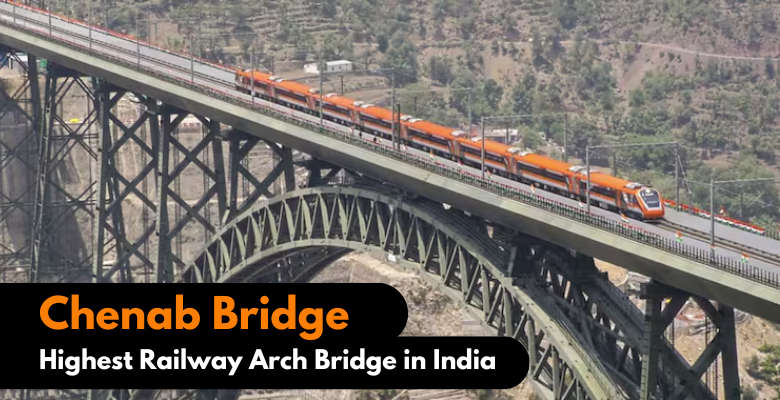
Chenab Bridge is not just a bridge — it’s a breathtaking symbol of India’s engineering brilliance, courage, and national unity. Nestled amidst the towering Himalayas, this steel giant is rewriting history as the world’s highest railway arch bridge. Standing taller than the Eiffel Tower, this majestic structure finally connects the picturesque Kashmir Valley to the rest of India through rail — a dream over 100 years in the making.
Let’s explore the top 10 incredible facts about Chenab Bridge, and how it’s changing everything from tourism to defence logistics and the economy in Jammu & Kashmir.
Contents
🌉 1. The World’s Highest Railway Arch Bridge
The Chenab Bridge, built across the Chenab River in Jammu & Kashmir, rises 359 metres above the river and spans 1,315 metres. That makes it 35 metres taller than the Eiffel Tower!
This engineering marvel is now officially the highest railway bridge in the world.
🚆 2. Connecting Kashmir to India by Rail
On June 6, a historic event unfolded when Prime Minister Narendra Modi inaugurated the long-awaited train service to Kashmir. This included the debut of two Vande Bharat trains specially for the Valley, marking a powerful step in national integration.
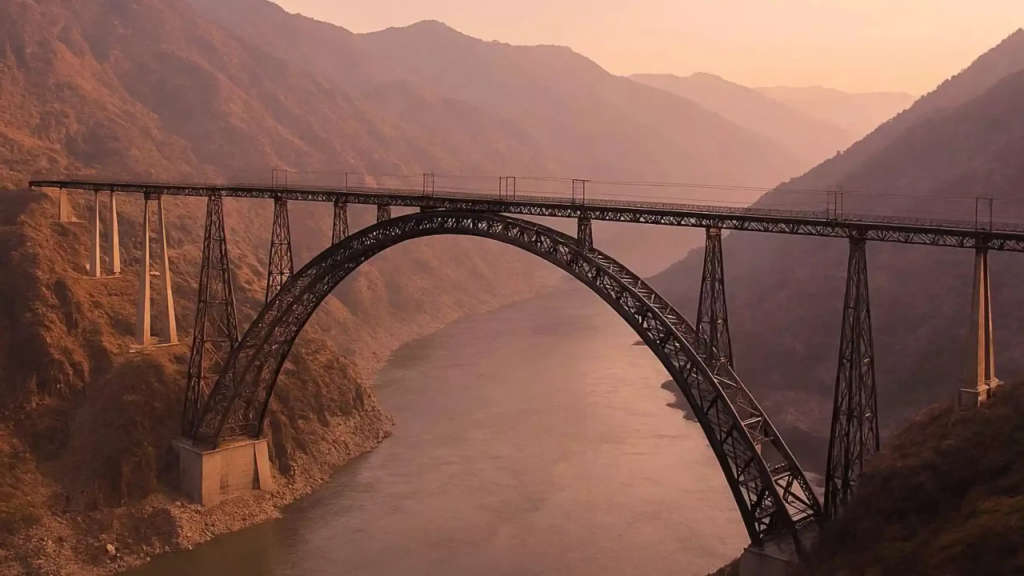
🏗️ 3. Unique Steel Arch Design
The bridge’s steel arch structure is the first of its kind in India. With no national code for such bridges, engineers followed British Standard BS: 5400 for design. A team led by Professor Madhavi Latha created the 469-meter main arch, supported by two 130-metre-high pylons.
🌨️ 4. Built to Survive Nature’s Fury
Chenab Bridge is blast-proof, earthquake-resistant, and can withstand:
- Winds up to 260 km/h
- Earthquakes up to 8 magnitude
- Temperatures as low as -20°C
It uses 63mm-thick blast-resistant steel and pillars designed to resist terrorist attacks.
🏔️ 5. Construction Challenges in the Himalayas
Building a bridge in such rugged terrain wasn’t easy:
- Initially, mules and horses transported materials.
- Temporary roads were built — 11 km on the north, 12 km on the south.
- Required: 25,000 tonnes of steel, 4,000 tonnes of reinforced steel, 46,000 cubic metres of concrete.
Stability of the slopes was a major concern, overcome with a design-as-you-go approach under Prof. G Madhavi Latha.
🛠️ 6. Technological Mastery
- Used world’s tallest cable cranes.
- Employed cantilever techniques from both riverbanks.
- The final crown joining of the arch happened in April 2021, a moment of victory for the engineering team.
To ensure safety and durability:
- A 15-year anti-corrosion paint was applied.
- A real-time monitoring system ensures passenger safety.
- Aerial surveillance protects the bridge.
🏰 7. A Century-Old Dream Fulfilled
The dream of connecting Kashmir by rail goes back to the 1890s under Maharaja Pratap Singh. It saw delays due to colonial neglect, wars, and funding issues.
Progress only picked up after 1983, when Indira Gandhi laid the foundation for the Jammu-Udhampur-Srinagar line. It gained momentum under the Modi government, leading to engineering wonders like the Chenab and Anji bridges.
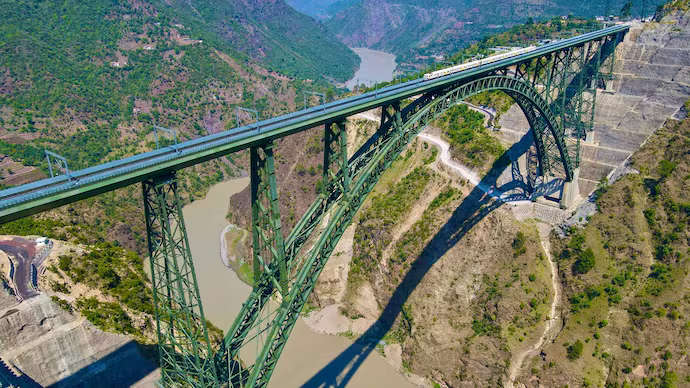
🎖️ 8. Strategic Importance Near Line of Control
Just 63 kilometres from the Line of Control, Chenab Bridge is a vital military and strategic asset. Its DRDO-approved blast resistance ensures that it can survive attacks without collapsing — a crucial advantage in border defence and logistics.
🏞️ 9. Boosting Kashmir’s Tourism
Tourism in Kashmir, badly hit by events like the April 22 Pahalgam terror attack, is expected to revive:
- Vande Bharat now connects Jammu and Srinagar in just 3 hours.
- Affordable chair car tickets (below ₹715) make travel easier.
- Safer, faster rail travel will increase tourist footfall and accessibility.
In pictures: India opens world’s highest single-arch railway bridge in Kashmir
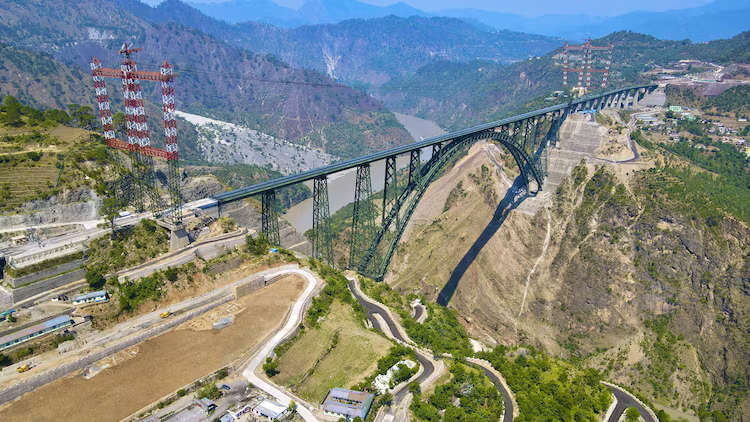
🍎 10. Economic Game-Changer for the Valley
Chenab Bridge is set to transform Kashmir’s horticulture and handicrafts sector:
- Faster transport of apples, saffron, and crafts to markets.
- Supports 3.5 million livelihoods.
- Reduces spoilage and cost of transport.
- Boosts exports, expected to hit ₹3,000 crore by March 2025.
With horticulture contributing nearly 7% to the region’s GSDP and 75% of India’s apples coming from here, this is a much-needed upgrade.
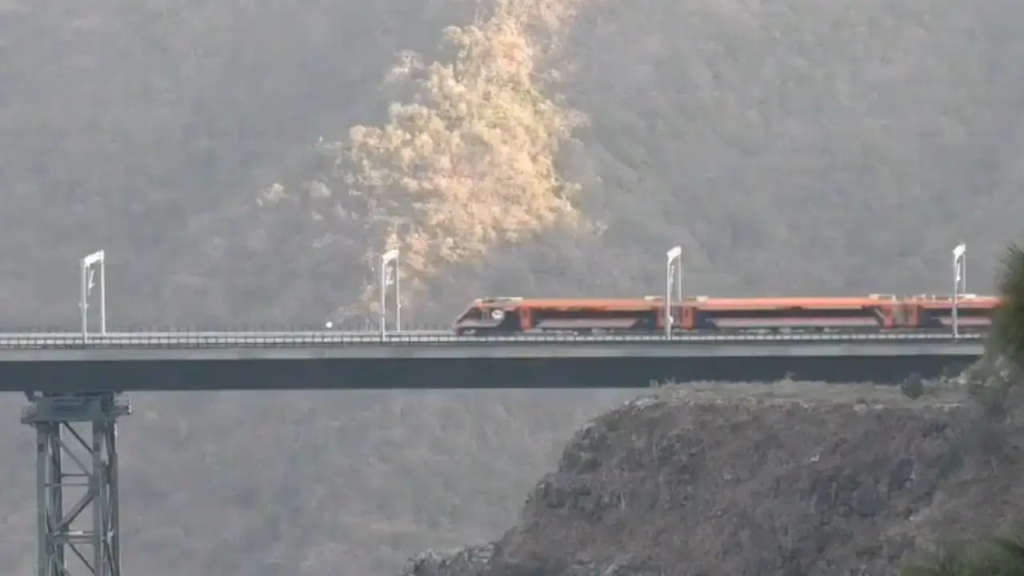
More Than a Bridge — It’s a Statement
The Chenab Bridge is not just steel and concrete; it’s a bold declaration of India’s capabilities. It’s a lifeline, a milestone, and a symbol of unity and courage. With its completion, India has proved that no terrain is too tough and no dream too distant.
Meet Madhavi Latha – The Woman Behind the World’s Tallest Rail Bridge, the Chenab Bridge
At an altitude that surpasses even the Eiffel Tower, the Chenab Rail Bridge is more than just an engineering wonder—it is a symbol of India’s determination, and at the heart of its creation is a woman whose grit and expertise made it all possible: Professor Madhavi Latha.
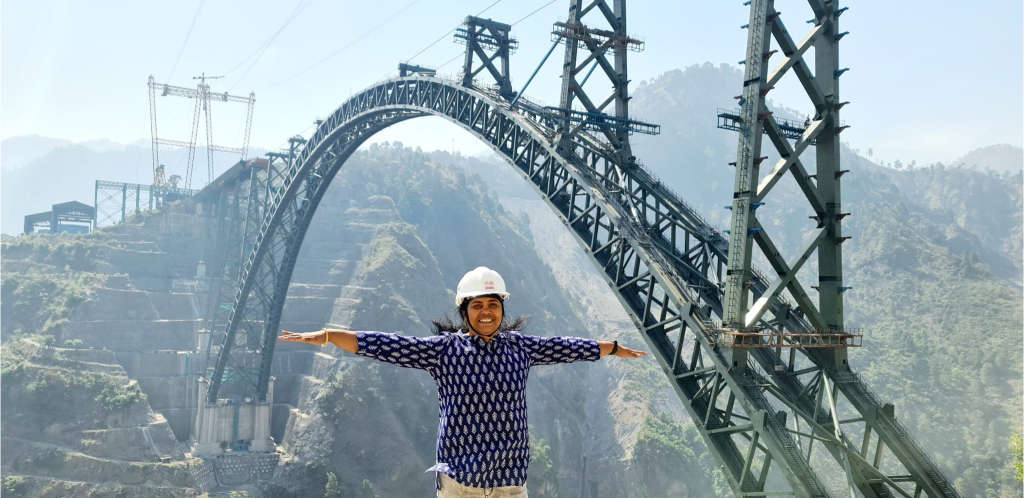
She isn’t just an engineer—she’s an inspiration. “I want young women to know that bridges, mines, and rock slopes aren’t off-limits to them. They belong there, too,” she says. And with her contributions to the world’s highest railway bridge, she’s proven that statement true.
A Visionary’s Role in a Monumental Project
The Chenab Bridge, towering at 359 metres above the riverbed and stretching across 1,315 metres, stands in the Reasi district of Jammu & Kashmir. It’s a key part of the Udhampur–Srinagar–Baramulla rail link, a lifeline connecting the remote Himalayan regions to the rest of India.
With a 467-metre-long steel arch, this project was a major technical challenge, especially in a region known for its tough terrain and seismic activity. This is where Professor Madhavi Latha stepped in.
Humble Beginnings and Academic Brilliance
Madhavi Latha was born in Yedugundlapadu, a small village in Andhra Pradesh. Her early dream was to become a doctor, but due to financial constraints, she pursued engineering—and became the first engineer in her community.
- She graduated in Civil Engineering from JNTU, Andhra Pradesh, in 1992 with distinction.
- She then completed her M.Tech in Geotechnical Engineering at NIT Warangal, earning a gold medal.
- In 2000, she began her Ph.D. at IIT Madras and went on to conduct post-doctoral research in Rock Engineering at IISc Bangalore, where she later became faculty.
She even had to fight for basic infrastructure. “There were no women’s toilets in my department,” she recalls. “I had to push for one to be made.”
Today, Madhavi Latha is the Chair of the Centre for Sustainable Technologies (CST) and a respected name in the field of geotechnical engineering.
Key Contributions to the Chenab Bridge
In 2005, when the bridge site revealed unexpected geological challenges like fractured rock faces, hidden cavities, and unstable slopes, Latha was called in. Northern Railways and Afcons Infrastructure, the lead construction company, sought her expertise.
Here’s how she played a pivotal role:
- Advised on slope stability and foundation design in a seismically active zone.
- Designed rock anchors, bolts, and retaining systems to secure the slopes and bridge base.
- Introduced a “design-as-you-go” approach, adjusting the plan based on real-time geological findings.
- Stepped in as a project advisor and ensured smooth progress even after a co-advisor exited.
- Documented the entire engineering journey in her technical paper “Design as You Go: The Case Study of Chenab Railway Bridge”, published in the Indian Geotechnical Journal.
Facing Harsh Terrains and Harsh Conditions
Constructing a bridge at such height was never going to be easy. The site was difficult to access, and the team faced cold weather, landslides, and the unpredictable nature of the Himalayan mountains. But Dr. Latha’s leadership and innovative thinking kept the project moving.
Recognitions and Awards
Madhavi Latha’s hard work hasn’t gone unnoticed:
- Best Woman Geotechnical Researcher Award (2021) – Indian Geotechnical Society
- Prof SK Chatterjee Outstanding Researcher Award – IISc
- Woman Achiever Award – Karnataka Book of Records
- SERB POWER Fellowship Recipient
- Featured in Top 75 Women in STEAM in India (2022)
When Prime Minister Narendra Modi inaugurated the Chenab Bridge on June 6, IISc proudly celebrated her team’s efforts on X (formerly Twitter):
“We are proud of Prof Madhavi Latha & her team’s contribution to the #ChenabBridge… stability of slopes, foundations, slope stabilization systems including rock anchors.”
Inspiring the Next Generation
Dr. Latha wants her journey to inspire others—especially young women. Her message is clear: Engineering, no matter how rugged or challenging, is for everyone.
In Her Own Words:
“I want young women to realise that rock slopes, mines, and bridges are not beyond them. They belong here, too.”

